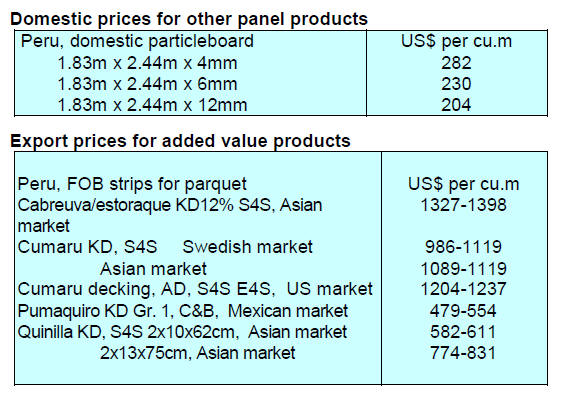4.
INDONESIA
Strengthening sengon timber network
The Ministry of Trade has plans to expand sengon
(Albizzia - lightwood) exports by facilitating business
meetings between sengon timber producers (mainly small
farmers in Central Kalimantan) as well as producers
throughout Indonesia.
At a recent meeting of stakeholders 25 sengon farmers
assisted by Fairventures Worldwide and member
companies of the Indonesia Light Wood Association
(ILWA) dicussed the ministry plans. At the same meeting
a ‘Letter of Intent’ was signed between Fairventures
Worldwide and ILWA as a commitment by both parties to
develop a lightwood value chain especially in Central
Kalimantan.
Fairventures Worldwide works in partnership with
communities and small farmers in Central Kalimantan to
take advantage of vacant land by planting fast-growing
trees such as sengon, which can provide an alternative
income for local communities. Sengon production is
sustainable in line with current market requirements.
In 2020, Indonesia's lightwood exports reached US$ 1.74
billion with Japan, the United States, South Korea, Saudi
Arabia and Taiwan as the main markets.
See:
https://infopublik.id/kategori/nasional-ekonomibisnis/582714/indonesia-berpeluang-kuasai-pasar-kayu-global
No more permits for primary and peat forest
harvesting
The policy of stopping the new permits issuance in
primary forest and peat has been shown to contribute in
reducing deforestation and forest degradation. Deputy
Minister of Environment and Forestry, Alue Dohong,
stated that the policy of terminating new permits in
primary natural forests and peat affects in drasticly
reducing in the rate of deforestation.
In an official statement Alue said "Indonesia has
succeeded in reducing the deforestation rate by 75%
compared to the previous year to 115,000 hectares in the
2019-2020 period."
See:
https://nasional.sindonews.com/read/597627/15/hentikanizin-baru-dan-perkuat-tata-kelola-hutan-gambutindonesia-turunkan-deforestasi-1636715488/10
APHI to support carbon sink target
The Association of Indonesian Forest Concessionaires
(APHI) has indicated its members are ready to support the
achievement of the target of higher carbon absorbtion than
greenhouse gas (GHG) emissions from the forest and land
use sector (Net Sink FoLU) in 2030 as decided by the
government.
To support the achievement of the FoLU Net Sink,
businesses will implement forestry multi-business
according to the Chairman of APHI, Indroyono Soesilo.
Under this multi-business scheme forest owners and
companies will not only focus on timber but also on the
utilistion of non-timber forest products and environmental
services. According to Indroyono, with a multiple forestry
businesses the value of forest will rise which will reduce
the pressure for land use conversion.
See:
https://www.antaranews.com/berita/2518245/aphi-siapdukung-pencapaian-target-net-sink-folu
Indonesian cooperation with Brazil and Congo
During discussion held at the Secretariat of the Delegation
of the Republic of Indonesia at the UNFCCC COP-26
cooperation with Brazil and the Democratic Republic of
the Congo was agreed in forest management and climate
change.
The three countries have management over a huge area of
tropical forest and it was agreed there are many areas for
collaboration according to the Deputy Minister of
Environment and Forestry, Alue Dohong. Specifically the
three countries shared ideas on each other's strengths in
climate action and forest management. They also
identified each other's capabilities that could be combined.
In this collaboration, Indonesia offered expertise in
reducing deforestation, controlling and handling forest and
land fires as well as its experience in social forest
management for communities.
Brazil has extensive experience in implementing payments
for ecosystem services (PES), managing climate funds
through the Amazon Fund as well as cooperating with
low-emission agricultural and livestock management
practices, waste management and sanitation which, said
Alue, will be valuable for Indonesia.
See;
https://www.medcom.id/nasional/politik/yKXjaVEbindonesia-kerja-sama-dengan-brasil-dan-kongo-terkaitpengelolaan-hutan
and
https://nasional.kontan.co.id/news/indonesia-brasil-dan-kongojajaki-kerja-sama-pengelolaan-hutan?page=2
Law enforcement key to curbing forest fires
Law enforcement is a potent tools to curb land and forest
fires in Indonesia according to Prof. Bambang Hero
Saharjo of the Bogor Agricultural University
(IPB University). If fires can be eliminated this will help
achieve the target of lowering greenhouse gas emissions
said the professor during a discussion at the Indonesia
Pavilion at the COP-26.
See:
https://en.antaranews.com/news/199293/law-enforcementis-tool-to-curbing-forest-fires-professor
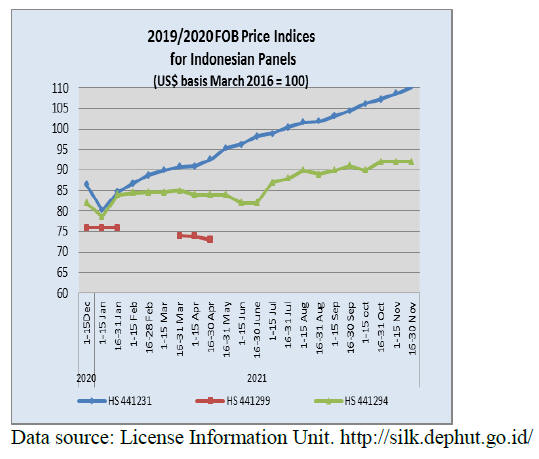
5.
MYANMAR
Violence condemned
On November 26 a statement was released by the US State
Department, Office of the Spokesperson. The following is
the text of a joint statement signed by the governments
of Australia, Canada, New Zealand, Norway, the Republic
of Korea, the United Kingdom and the United States.
“We reiterate our grave concern over reports of ongoing
human rights violations and abuses by the Myanmar
Security Forces across the country, including credible
reports of sexual violence and torture, especially in Chin
State, Sagaing Region and Magwe Region.
In Chin State, it is reported the military has burned homes,
churches and an orphanage in Thantlang village, and has
targeted humanitarian organizations. More than 40,000
people are reported to have been displaced in Chin State
and 11,000 in Magwe Region as a result of recent
violence.
Reports of internet shutdowns and other methods of
communication in Chin State and other areas of the
country are also troubling. Communities impacted by
violence need access to information to keep themselves
safe.
We are concerned about allegations of weapons
stockpiling and attacks by the military, including shelling
and airstrikes, use of heavy weapons and the deployment
of thousands of troops accompanying what security forces
assert are counter-terrorism operations, which are
disproportionately impacting civilians. We also note our
increasing concern at armed clashes in Rakhine State in
early November”.
See:
https://www.state.gov/joint-statement-on-increasingviolence-in-myanmar/
Myanmar’s Ministry of Foreign Affairs raised strong
objections on 27 November to the ‘biased’ joint saying it
“contained sweeping and groundless accusations against
the Tatmadaw (army ) such as human rights violations
and the disproportionate use of force.”
Teak log prices stable
The Myanmar Timber Enterprise (MTE) offered around
735 tons of teak logs for tender sale recently and the prices
bid were little changed from previous sales. However, all
lots of Sawing Grade 4 logs received no bids.
Generally, Sawing Grade 4 logs are processed to high
quality products for niche markets in the EU and USA.
The EU announced trade restrictions targeting the MTE in
June this year and before these became effective
manufacturers tried to stock- up on logs and have switched
to alternative markets but these markets may not require
the top quality timber from Sawing Grade 4 logs.
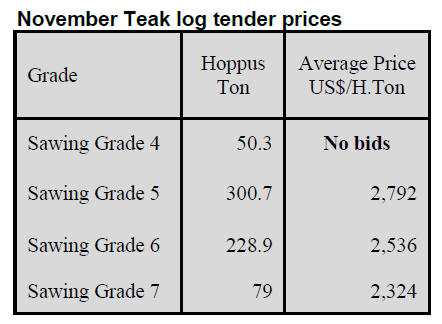
6. INDIA
India’s response swift and
substantial says IMF
In October the International Monetary Fund concluded
consultations on the economy with India. A recent press
statement says “India’s economy is poised for a rebound
after enduring a second wave of COVID-19 infections this
year that further constrained activity and took a heavy toll
on its people“.
New infections have fallen significantly and vaccination
rates have risen to surpass a billion doses, although a
resurgence is possible even if it seems unlikely today. The
IMF says India was among the fastest-growing economies
in the world in the decade before the pandemic which
created unprecedented challenges. The two COVID-19
waves caused health and economic crisies however, the
economy is gradually recovering.
The IMF note that the authorities’ economic response, was
swift and substantial as it included fiscal support such as
scaled-up support for vulnerable groups, monetary policy
easing, liquidity provision and accommodative financial
sector and regulatory policies.
According to the IMF growth is projected at 9.5% in the
finacial year 2021/22 and 8.5% the following year.
However, taming inflation, projected at 5.6% in
FY2021/22 will be a challenge.
See:
https://www.imf.org/en/News/Articles/2021/11/02/na111121-indias-economy-to-rebound-as-pandemic-prompts-reforms
Still a way to go to recover housing market
According to the results of a survey by Deloitte Touche
Tohmatsu India LLP (Deloitte India) the pandemic has
altered home buyer preferences. The report from Deloitte
sets out the key trends that are expected to contribute to
the revival of the Indian real estate sector.
The impact of the pandemic control measures had a very
varied impact with the hospitality and manufacturing
sectors being badly affected and since restrictions were
eased the rebound has been equally uneven.
A revival of government infrastructure projects is helping
the manufacturing and construction sectors but consumer
anxiety is holding back a recovery of the services sector.
However, a recovery is taking root as witnessed by recent
high-frequency data but there are some challenges such as
high inflation, the need for more job creation, poor wage
growth and reduced asset values and these will affect
consumer purchasing power.
Despite the anticipated rebound in 2022 output levels are
likely to remain much below the pre-pandemic GDP levels
according to the results of the survey.
The authors of the survey write “With industries showing
immense resilience through innovative ways during the
pandemic and India now gradually making its way toward
recovery, growth sustainability in 2021 will depend on
widespread vaccine deployment and effective government
measures”.
See:
https://www2.deloitte.com/global/en/insights/economy/asiapacific/india-economic-outlook-01-2021.html

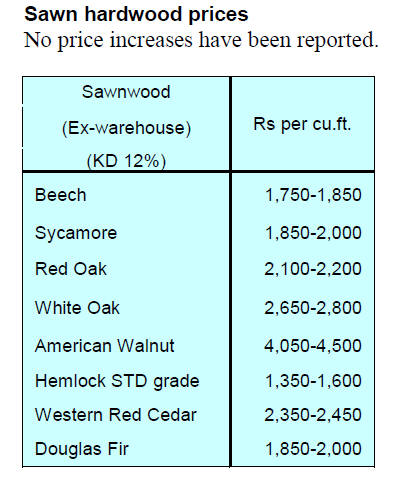
Plywood
A survey of panel retailers conducted and reported by
Plyreporter says market demand has been recovering
steadily since September despite the earlier panel price
increases. With rising costs of imported and domestic raw
materials for the panel sector further price increases
cannot be ruled out.
New ply mill gets approval
Andhra Pradesh State Investment Promotion Board (SIPB)
has approved investment proposals from five industries
worth almost US$300 million. Century Plyboards India,
one of the investors, will establish a plywood unit at
Badvel with an investment of around US$100 million and
the industrial unit is expected to generate over 2,000 jobs.
The mill will utilise eucalyptus grown by local farmers.
Vietnam's pine sawn wood.
See:
https://www.thehindubusinessline.com/news/national/apgovt-clears-5-new-industry-investments-worth-2134-cr/article37529125.ece
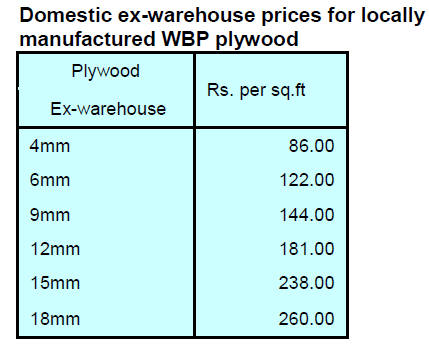

7.
VIETNAM
Wood and Wood Product (W&WP) trade highlights
According to the General Department of Customs W&WP
exports to Japan in October 2021 reached US$121 million,
increasing 4% compared to October 2020. In the first 10
months of 2021 W&WP exports to Japan reached US$1.16
billion, up 10.6% over the same period in 2020.
In October 2021, exports of W&WP to Germany reached
US$9.8 million, down 21% compared to October 2020,
but compared to September 2021, they increased by 60%.
The recovery in production from the end of September
2021 boosted export growth in October 2021 and in the 10
months of 2021 exports to Germany reached US$101
million, up 7% over the same period in 2020.
Imports
d imports in October 2021 are estimated at 130,800 cu.m
worth US$36.6 million, up 10.6% in terms of volume and
11.3% in value compared to September 2021.
Compared to October 2020, imports of pine sawn wood
increased by 40% in volume and 77% in value. In general,
in the first 10 months of 2021 pine wood imports reached
1.246 million cu.m worth US$300.8 million, up 75% in
volume and 98% in value over the same period in 2020.
Imports of wood from China in October 2021 reached
33,000 cu.m with a value of US$18.5 million, up 11.8% in
volume and 12% in value compared to September 2021
but down 56% in volume and 36% in value compared to
October 2020.
In the first 10 months of 2021 imports of raw wood from
China reached 892,860 cu.m with a value of US$57.08
million, up 60% in volume and up 59% in value over the
same period in 2020.
Exports starting to recover
Demand in international markets continues to grow
creating a solid foundation for recovery of the Vietnamese
furniture processing and exporting industry.
Speaking at a webinar "Strategy to revive the supply chain
of the furniture industry in Vietnam" Mary Tarnowka,
Managing Director of AmCham Vietnam said the recent
period of implementing social distancing to fight the
pandemic has been a huge challenge for businesses,
including American furniture manufacturers in Vietnam
with a large number of orders that have been affected.
The fourth quarter is a very important period for the US
market especially during the Christmas and Thanksgiving
holidays so companies are doing their best to prepare to
meet orders for these holidays.
Ms. Tarnowka also said demand for Vietnamese wood and
furniture products will continue to grow in 2022 and 2023.
However, in the next six months while orders will increase
manufacturers in Vietnam will continue to struggle to
recover 100% capacity.
“This will have a negative impact on US buyers, in
addition to the high freight rates. There are a number of
US businesses that have moved orders to China and it will
be difficult to call them back to Vietnam. It is important to
reopen quickly, resume manufacturing operations, rebuild
supply chains and promote sustainability and innovation in
the industry,” said Ms. Tarnowka.
The same opinion was voiced by Alain Cany, President of
EuroCham who acknowledged: “The time to implement
social distancing is a bad time for European businesses in
Vietnam, because this is the time when many orders are
received. While orders from Germany, France and the
Netherlands are "booming", everything in Vietnam has
stopped.”
Accordingly, businesses there are still many difficulties
and challenges such as shortage of raw materials, increases
in raw material prices, labour shortages which holds down
factory capacity. Worst of all shippers cannot find
containers.
Deputy Director of the General Department of Forestry
(Ministry of Agriculture and Rural Development) Bui
Chinh Nghia said "Vietnam's wood industry is ready to
recover and speed up after the Covid-19 pandemic" .
He said 95% of wood workers have been vaccinated
against Covid-19 with the 1st dose and 60% have received
the 2nd dose. The Ministry of Agriculture and Rural
Development is making efforts to coordinate with the
Ministry of Health to prepare 136,000 doses of the vaccine
for further vaccination of workers to gain immunity.
The labour issue he said the local People's Committees
also support enterprises in recruiting workers. Along with
that, the Government and localities have also implemented
solutions to actively support businesses in ensuring supply
chains, finding outputs, building operating models,
transportation, travel and financial problems for
enterprises to restore production.
The recovery of the timber industry will be in three phases
in which the adaptation phase will take place over three
months with employment being maintained and factories
operating. The goal of this phase is to restore 70% of the
production with sales estimated at US$900 million to
US$1.2 billion per month.
The recovery period will last for 3-6 months to prepare for
the new production season with new orders. The goal of
this phase is to restore 90% of factories and expect
revenue of US$1.2-1.4 billion per month. An acceleration
phase is expected to begin in 6 months with investment in
opportunities and growth with an expected growth rate of
15% compared to 2021.
Nguyen Hoai Bao, Deputy General Director of Scansia
Pacific Company (Dong Nai province) said that Dong Nai
province has now allowed workers to live in green areas or
if they have received one dose of the Covid-19 vaccine to
returning to work. This helps the company have more
workers and workers can also return home instead of
staying at the factory as before.
From the perspective of the association, Do Xuan Lap,
Chairman of the Vietnam Wood and Forest Products
Association, said that despite difficulties, opportunities for
Vietnam's furniture industry are still wide open.
Enterprises themselves are aware of the great opportunities
so they have been looking for ways to adapt to the new
conditions from retaining workers, finding a stable source
of raw materials to applying machinery and modern
equipment to reduce dependence on human resources and
to improve product quality.
See:
https://wtocenter.vn/chuyen-de/18379-export-of-woodfurniture-ready-to-recover-speed-up-after-the-pandemic
8. BRAZIL
Bio-economy essential for Amazon
security
The Sustainable Amazon Forum (Fórum Amazonia
Sustentável - FAS) coordinated by the Ethos Institute and
eight other organisations that make up the Organising
Committee comprises a multi-sectoral initiative aimed at
securing a sustainable Amazon.
At COP-26 a FAS document "10 points for a bioeconomy
in the Amazon," set out how to create a circular economy
and low-carbon model that keeps the forest secure,
protects local communities and effectively eliminates
deforestation.
The 10 points considered to be priorities for the region are:
Actions to combat deforestation
Land regularisation
Environmental protection and inspection
Fair and sustainable value chains
New forest economies
Social and economic inclusion of local
communities
Infrastructure and energy
Financial instruments and incentives
Business environmental impacts
Multi-sectoral governance.
According to Institute Ethos the FAS initiative is a
valuable contribution as it gives relevance to regional
voices pointing out the true priorities capable of
reconciling the preservation of biodiversity with the wellbeing
of local populations. Adding, the complex scenarios
in the Amazon demand multi-sectoral action and this
document provides ideas to advance a consensus on how
to move forward with concrete proposals for the
sustainable development of the region.
See:
http://www.madeiratotal.com.br/forum-amazoniasustentavel-lanca-nesta-quinta-na-cop26-o-documento-10-pontos-para-uma-bioeconomia-da-floresta-em-pe/
‘Green Brazil consortium’ seeking resources for the
Amazon plan
At COP-26 State Governors from Brazil launched the
‘Green Brazil Consortium’ (Consórcio Brasil Verde)
setting out how States can advance their climate agendas.
The focus of the ‘Green Brazil Consortium’ is to secure
greater technical inputs so credible proposals can be
developed to attract financing.
The creation of the Consortium was promoted as a single
entity aimed at raising funds for climate action and the
generation of renewable energy. This Consortium is timely
in light of Brazil´s Nationally Determined Contributions
(NDC) commitment and marks an important step
articulation of subnational climate and socioenvironmental
governance in the country.
The priority now is for the States to draft carbon neutral
plans. As an example of the effort of Brazilian states with
carbon neutrality, the state of Mato Grosso, one of the
largest tropical timber exporting states, is working with an
environmental agenda aiming at zero carbon emissions by
2035.
See:
https://www.riotimesonline.com/brazilnews/brazil/governors-launch-green-brazil-consortium-at-cop26/
Export update
In October 2021 Brazilian exports of wood-based products
(except pulp and paper) increased 26.5% in value
compared to October 2020, from US$293.9 million to
US$372.0 million.
Pine sawnwood exports grew 58% in value between
October 2020 (US$47.1 million) and October 2021
(US$74.4 million). In volume, exports increased slightly
over the same period, from 267,900 cu.m to 268,900 cu.m.
However, tropical sawnwood export volumes fell 30%
from 40,200 cu.m in October 2020 to 28,000 cu.m in
October 2021. In value terms exports declined by the same
amount (30%) from US$15.8 million to US$11 million
over the same period.
The value of pine plywood exports saw an almost 5%
increase in October 2021 compared to October 2020 from
US$60.5 million to US$63.3 million. But in terms of
volume exports decreased 26% from 207,900 cu.m to
154,400 cu.m.
As for tropical plywood, exports increased in volume
(54.8%) and in value (124.0%), from 6,200 cu.m (US$2.5
million) in October 2020 to 9,600 cu.m (US$5.6 million)
in October 2021.
The value of wooden furniture exports increased from
US$57.2 million in October 2020 to US$78.1 million in
October 2021, an almost 37% increase.
Brazilian furniture exports growing
Brazil's main trading partner is the US but other markets
are also gaining in importance as opportunities for
Brazilian furniture exports in different parts of the world
expand.
In the first nine months of 2021 there was a 59% increase
in the value of furniture exports compared to the same
period in 2020. In September 2021 Brazil exported
furniture worth around US$79.6 million (FOB). All
segments showed increased exports.
The main importing countries of wooden furniture in
September were the United States followed by Chile and
the United Kingdom. Other countries such as Paraguay
and Panama, among other countries, have been attracting
the exporters attention.
See:
http://www.megamoveleiros.com.br/author/admin/
In related news, overall timber exports are on the rise. In
the first six months of the year exports were 86% of the
full year 2020 totalling 1.18 million tonnes to AgroExport.
The Santa Catarina State Association of Forestry
Companies has indicated that the expectation is that in the
second half of 2021 the average of the first half will be
maintained. Positive numbers are expected to remain until
the end of the year. A slight reduction in exports may be
caused as the price of freight remains high and shipping
containers are not readily available.
As inflation rises and the currency slips against the US
dollar there have been increases in the cost of inputs for
the industry such as for wood, paint, glue and also basic
inputs such as electricity, diesel oil and others.
The timber industry in the State is doing its best to get
around these problems. Major companies are getting
organised and together, they are carrying out the reverse
logistics of containers. In other words to fulfill the preestablished
contracts they are paying the freight for
containers to come empty.
The Paranaguá Container Terminal (TCP) is used for
exporting wood products and has a strategy to help its
customers with this problem offering customers the option
to export in break-bulk which offers a huge saving in
freight costs. The freight in this operating model is
approximately US$ 40/cu.m cheaper than the container
said the TCP.
Between January and August 2021, the terminal exported
23,118 containers, an increase of 3% over the same period
in 2020. Since the beginning of the year, TCP have
exported 25,262 units to date.
See:
https://www.portosenavios.com.br/noticias/portos-elogistica/exportacao-de-madeira-cresce-no-brasil
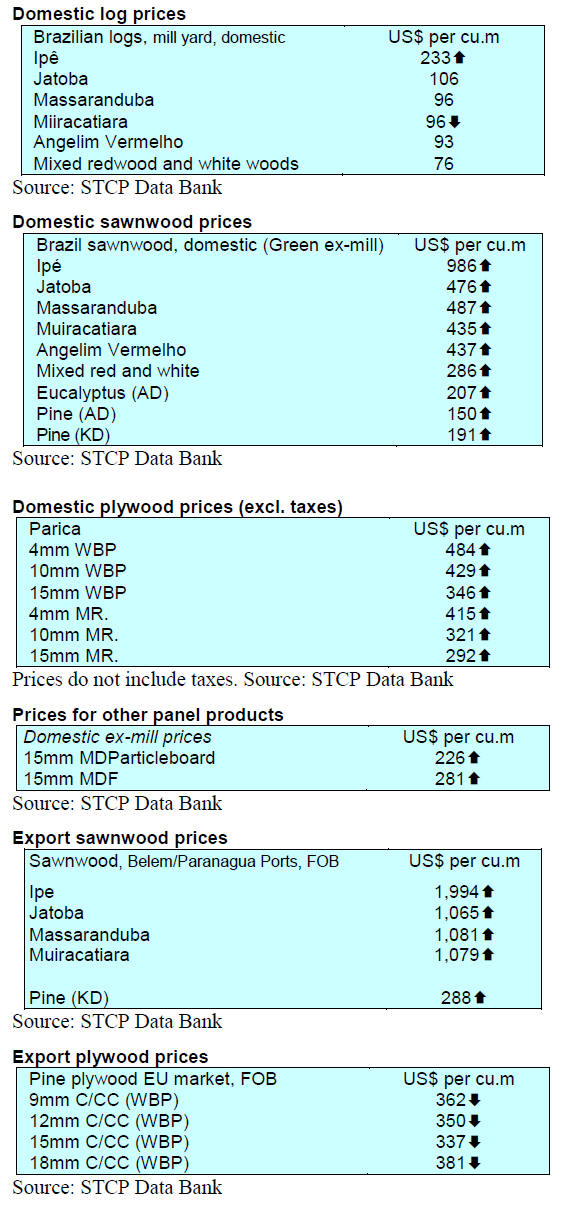

9. PERU
Exports to recover to pre-pandemic
levels by the end
of 2021
Peru’s wood product exports for the third quarter of this
year totalled US$86 million, 35% more than the same
period in 2020 but still far from the more than US$100
million in 2019. However, the Association of Exporters
(ADEX) and ComexPerú are projecting that that this year's
timber exports may exceed pre-pandemic levels.
Rafael Zacnich, Manager of Economic Studies at
ComexPerú, pointed out that this year wood product
export earnings could reach the levels of 2019 however, he
indicated that this does not mean a sign of recovery in
general but more evidence of the declining trend in export
earnings since the US$230 million in 2008.
He explained that the country has around 73 million
hectares of forests but with only a little more than one
million ha. certified and the risk of deforestation persists.
Against this background he commented that one of the
most critical problems is the lack of forest supervision and
control since the State allocates barely US$3.2 million
annually for that work but that the budget is often
underspent.
Erick Fisher, president of ADEX, noted that 95% of
deforestation in Peru is due to illegal logging by
subsistence farmers in the Amazon. He urged a greater
development of the ‘formal’ wood industry so that the
country can implement sustainable policies in forestry.
SERFOR roadmap to strengthen forest management
In order to strengthen strategic alliances with the Loreto
Regional Government the Executive Director of the
National Forest and Wildlife Service (SERFOR), Levin
Rojas, held a working meeting with the Regional
Governor of Loreto. The meeting focused on reducing the
gaps in the sustainable use of forest and fauna resources in
the region, identifying opportunities for improvements that
can lead to action.
Levin Rojas presented the KFW Forestry Programme
which will provide support to strengthen the capacities of
technical teams and users of forestry and wildlife services
as well as promoting greater investment in forestry
projects and review of goals to promote sustainable forest
production in the natural forests of Loreto.
International public tender for the
‘Program for the
Promotion and Sustainable Management of Forest
Production in Peru’
On 24 November 2021 a prequalification notice was
posted for an International and Open Public Service to
contract Technical Assistance Services to Support the
Implementation of the Program for the Promotion and
Sustainable Management of Forest Production in Peru.
For details see:
https://www.gtai.de/gtaien/trade/tenders/peru/consulting-services-sustainablemanagement-of-forest-production--759616

